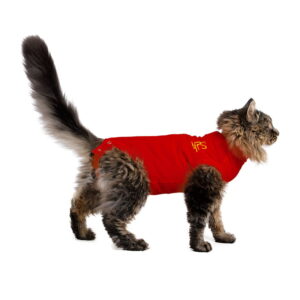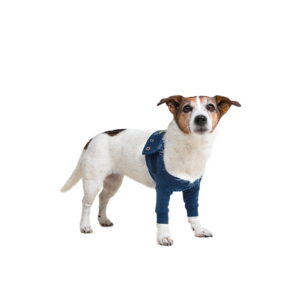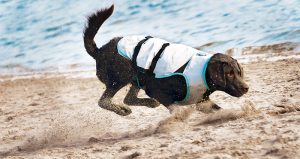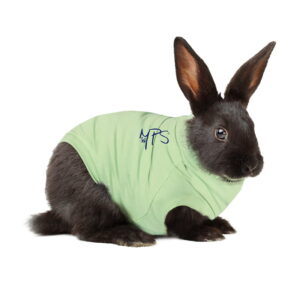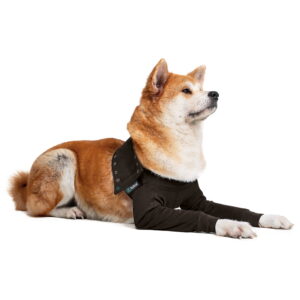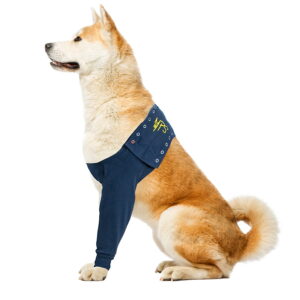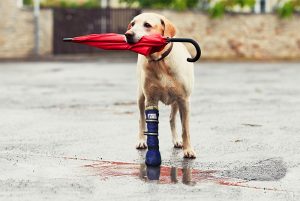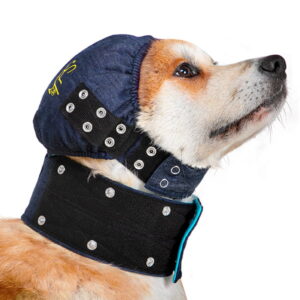0
Can My Pet Sleep in a Recovery Suit? Comfort and Safety Explained
Short answer: Yes. Most dogs and cats can safely sleep in a recovery suit (also called a recovery shirt, surgical suit, onesie, or bodysuit) if it fits snugly, is breathable, and you monitor for overheating or chafing. Ensure easy potty access and remove daily for skin checks and washing.
Estimated reading time: 6–8 minutes Last updated: 13 May 2025 Author: Gavin Levenstein
Key takeaways
- Safe for overnight: Choose a breathable, well-fitted suit and monitor comfort.
- Fit matters most: It should be snug, not tight—use the two-finger test at the neck and chest.
- Potty access: Use the built-in flaps/cutouts correctly; check bedding overnight.
- Heat and chafe checks: Watch for panting, warm ears/belly, and redness under the armpits or groin.
- After spay/neuter: Expect 10–14 days of use (or as your vet advises), including sleep.
- Buy two suits: One to wear, one to wash—so your pet is never uncovered during laundry.
What is a recovery suit and how does it work? A recovery suit is a specially designed garment for dogs or cats that shields surgical sites, hot spots, or skin conditions. Unlike a rigid cone (Elizabethan collar), a recovery shirt wraps the torso like a soft, stretchy tee, limiting access to wounds while allowing natural movement. That gentle, all-round pressure can feel calming—much like swaddling—helping anxious pets settle and sleep.
Is it safe for dogs and cats to sleep in a recovery suit? Yes—provided the suit fits properly and uses breathable, moisture-wicking fabric. Quality suits (like Suitical or MPS) are designed for round-the-clock wear, including naps, crate time, and overnight sleep.
What to check for safe sleep
- Breathable fabric: Cotton-lycra or poly-cotton blends help prevent overheating and skin irritation.
- Proper fit: Snug through the chest and belly, not restrictive. Your pet should walk, lie down, curl up, and stretch comfortably.
- Potty setup: Use the built-in flaps/cutouts so urine or stool won’t soil the fabric.
- Night checks: In the first 1–2 nights, do a quick feel of ears and belly (too hot?) and look for any rubbing at the armpits, groin, and neck.
How do recovery suits support healing during rest? Sleep is when the body does its best repair work. By blocking licking and scratching (major causes of delayed healing and infection), a surgical bodysuit protects the site while reducing stress from a cone. Calmer pets sleep more deeply—and that supports a stronger immune response and faster recovery.
Cone vs recovery suit for overnight comfort
- Recovery suit (onesie/shirt)
– Pros: Comfortable for sleeping and cuddling, allows side and belly sleep, reduces anxiety for many pets, protects large areas, easier indoors at night. – Cons: Needs correct size and daily checks; fabric must stay clean and dry.
- Cone (Elizabethan collar)
– Pros: Prevents access to head/face wounds; simple to fit. – Cons: Bumps into furniture, can disturb eating/drinking and sleep positions; many pets become restless at night.
Not sure what to choose? Read our guide: From a cone to a recovery shirt (https://www.tailme.co.za/from-a-cone-to-a-recovery-shirt/) and shop our Recovery Suits (https://www.tailme.co.za/product-category/medical-recovery/).
After spay/neuter: how long should pets wear a recovery suit? Always follow your vet’s advice, but here’s typical guidance:
- Days 0–3: Wear full-time (including overnight). Short removals only for skin checks and washing.
- Days 4–7: Continue full-time wear. Gentle, on-lead potty breaks only.
- Days 8–14: Keep wearing overnight until the incision is closed and cleared by your vet.
- Other procedures:
– TPLO/ACL and larger surgeries: Suits can help protect incisions and prevent licking overnight—often needed for 14–21 days. – Hot spots/dermatitis/allergies: Use overnight while the skin heals and itching subsides (duration varies).
Preventing overheating and chafing at night
- Signs of overheating: Rapid panting at rest, warm ears or belly, restlessness, drooling, or seeking cool floors. If present, remove the suit, cool the room, and call your vet if symptoms persist.
- Fit to prevent rub: If you see redness under the armpits, inner thighs, or around the neck, the suit may be too tight or too loose. Adjust size or try a style with softer binding.
- Summer tip: Keep the room cool and well-ventilated; consider a fan or AC. For heat-prone pets, pair daytime use with a Dry Cooling Vest (https://www.tailme.co.za/product/suitical-dry-cooling-vest/) when supervised.
- Winter tip: The suit can be a cozy base layer; avoid piling on heavy blankets that trap heat.
Sizing and potty access tips
- Measure twice: Chest girth, back length, and neck. Then check the brand’s size chart. Start here: How to Choose the Right Recovery Suit Size and Style (https://www.tailme.co.za/how-to-choose-the-right-recovery-suit-size-and-style/).
- The two-finger rule: You should slide two fingers under the neck and chest panels comfortably.
- Belly/leg freedom: Your pet should take full, comfortable strides with no pulling at the armpits.
- Potty routine: Practice fastening/unfastening the potty flap before bedtime. Last-call potty break, then a quick morning check for any dampness on the fabric or bedding.
- Crate sleeping: Suits are safe in a crate if your pet can lie comfortably and stay cool. Use breathable bedding and remove bulky harnesses.
Species, breed, and size notes
- Small/slinky bodies (e.g., Italian Greyhounds, cats): Prioritise a snug waist and chest to prevent wriggling out.
- Deep-chested dogs (e.g., Boxers, Vizslas): Check chest depth and back length carefully; choose brands with stretchy panels.
- Flat-faced breeds (e.g., Pugs, Persians): Higher heat-risk—keep rooms cool and monitor panting closely overnight.
- Indoor-only cats: Most learn litter box use in a suit quickly; keep litter low-sided for the first few nights.
Night-time recovery checklist
- Last potty break and water top-up
- Fasten potty flap correctly
- Quick feel for warmth at ears/belly
- Peek at armpits/groin for redness
- Keep the room cool and quiet
- Morning: unfasten for a 2-minute skin check
FAQs Q: How long can a dog wear a recovery suit after spay? A: Commonly 10–14 days, including overnight, or as your vet instructs. Remove briefly each day for skin checks and to wash the suit.
Q: Can my pet overheat in a recovery suit at night? A: It’s uncommon with breathable fabrics, but it can happen in warm rooms or heat-sensitive breeds. Keep the room cool, monitor panting, and choose moisture-wicking materials.
Q: Can a recovery suit replace a cone overnight? A: For most body and abdominal incisions, yes. For wounds on the head, face, or tail tip, your vet may still recommend a cone or a combination of cone + suit.
Q: How tight should a recovery suit be? A: Snug, not tight. You should fit two fingers at the neck and chest. If you see rubbing at the armpits or difficulty moving, adjust size or style.
Q: What if there’s chafing under the armpits? A: Stop, check sizing, and smooth any wrinkles. You can add a soft under-tee for a night, but replace the suit with a better-fitting style as soon as possible.
Q: Can cats use the litter box while wearing a recovery suit? A: Yes—when the flap is secured correctly. Use a low-sided box for the first nights and check for any litter sticking to fabric.
Q: Can a dog wear a recovery suit to bed and in a crate? A: Yes. Ensure the crate is well-ventilated, bedding is breathable, and your dog can lie on their side comfortably.
Q: How many recovery suits do I need? A: Two is ideal—one to wear and one to wash. Post-op hygiene is crucial to prevent infection.
When should I remove the suit?
- Daily: Briefly remove for a full skin check and to launder.
- Vet visits: Take it off so your vet can inspect the site.
- End of recovery: Follow your vet’s timeline; if licking resumes, continue use a bit longer.
Shop trusted recovery suits and helpful add-ons
- Shop Recovery Suits for Dogs (https://www.tailme.co.za/product-category/medical-recovery/)
- Shop Recovery Suits for Cats (https://www.tailme.co.za/product/suitical-at-home-recovery-suit-cat/)
- Dry Cooling Vest for heat-prone pets (https://www.tailme.co.za/product/suitical-dry-cooling-vest/)
Tip: Buy 2 and rotate daily for cleanliness and comfort. See our Shipping (https://www.tailme.co.za/shipping/) and Returns (https://www.tailme.co.za/refund_returns/) pages for peace of mind.
A gentle note from TailMe If this is your pet’s first night home after surgery, you’re doing great. Keep things calm, follow your vet’s plan, and use the suit as a comfy shield so everyone sleeps a little easier.
Further reading and sources
- AVMA: Post-surgical care for pets (https://www.avma.org/resources/pet-owners/petcare/your-pets-surgery)
- TailMe: How to Choose the Right Recovery Suit Size and Style (https://www.tailme.co.za/how-to-choose-the-right-recovery-suit-size-and-style/)
- TailMe: From a cone to a recovery shirt (https://www.tailme.co.za/from-a-cone-to-a-recovery-shirt/)
This guide is informed by veterinary best practice. Always follow the instructions given by your own veterinarian, who knows your pet’s specific needs.

